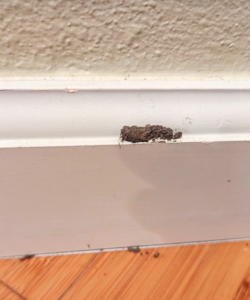Subterranean Termites: The Hidden Threat Beneath Your Home
 I spotted a small mud tube on the second-story hallway of my Vista residence. At first glance, it looked like something my dog might have tracked in from the yard. But as a licensed termite inspector, I knew better. This was a tell-tale sign of subterranean termites that had somehow made their way up to the second floor and chewed through the baseboard.
I spotted a small mud tube on the second-story hallway of my Vista residence. At first glance, it looked like something my dog might have tracked in from the yard. But as a licensed termite inspector, I knew better. This was a tell-tale sign of subterranean termites that had somehow made their way up to the second floor and chewed through the baseboard.
Outside, I checked for a mud tube along the foundation, expecting a visible path up from the ground. But there was none. This meant the termites had found a crack in the foundation, and made their way up through the walls, all the way to the second story.
The root cause? A slow plumbing leak under my second-story bathroom sink had gone undetected for about a month. By the time I found it, the moisture had seeped into the soil below, attracting foraging termites to my home. Had these termites not ventured out, they could have continued feasting on the studs in my walls for months. Luckily, I caught them early and was able to complete a localized treatment in the affected area and a soil treatment around the house perimeter.
Unlike drywood termites, subterranean termites don’t live in the wood. They don’t need to push their droppings out, to create space as their colonies grow. Subsequently, they can be more difficult to detect. Many times subterranean termites are only discovered when they swarm or during a remodel.
To prevent infestations like this, it’s essential to be proactive. Termite inspectors go beyond checking for active evidence—we also look for conditions that encourage infestations, such as:
- Planters directly touching the house
- Soil levels reaching or exceeding stucco
- Wood debris on the soil near the home
- Nearby stumps
- Wood piles on soil
- Wood decks and planters without concrete insulation
- Buried railroad ties in landscaping
- Leaks and faulty plumbing
If any of these conditions are present around your home, consider hiring a professional termite company to complete a perimeter soil treatment. Soil treatments are effective because termites entering the treated area will transport the termiticide back to the colony. According to the manufacturer, the termiticide can remain effective in the soil for up to eight years. While it may be an investment, it’s far less than the cost to repair their potential wood damage.
